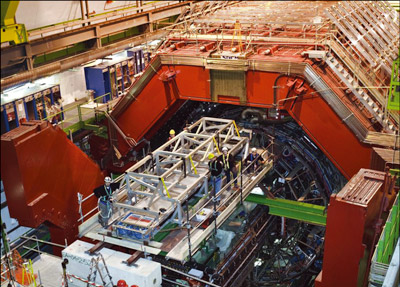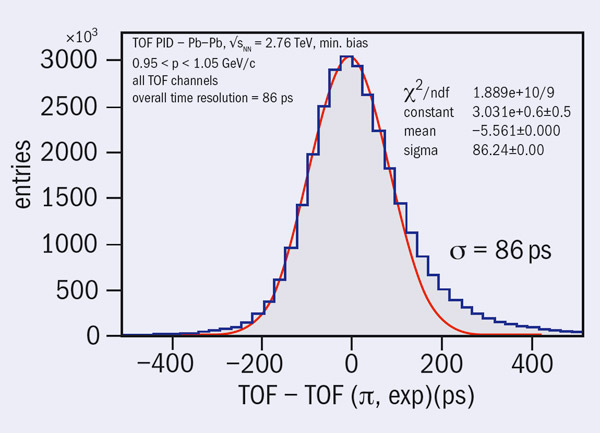
The ALICE detector is optimized to investigate collisions of heavy-ions – in practice lead–lead (Pb–Pb) – in which the production of quark–gluon plasma (QGP), a new state of matter, will provide invaluable insight into the “quark–gluon coloured world”. Many aspects of this new state make particle identification an obligation, especially in the study of strangeness enhancement and heavy-flavour production. One technique developed for ALICE is based on relatively “low-tech” detectors, considering the many areas of frontier technology employed at the LHC, but its performance is proving surprisingly good.
Time-of-flight (TOF) is one of several methods that ALICE uses to identify particles. In the mid range of momenta (0.5–2.5 GeV/c) the TOF array shows an excellent performance in separating pions from kaons. The system is based on the multigap resistive plate chambers (MRPCs), first developed in 1996. When built with small gas gaps, this type of detector shows exceptionally good intrinsic time resolution, below 50 ps – and full efficiency.
The ALICE TOF is made of 1593 MRPCs, each of which is 120 cm long and consists of a double-stack MRPC, with a total of 10 gaps 250 μm wide. The unusual feature of the device, however, is that even though the time resolution is at the cutting edge, the technology itself is relatively low-tech.
The resistive plates are made out of thin (400–550 μm thick) sheets of “soda-lime” glass (window glass) and fishing line is used to create the 250 μm spacing between the sheets. The simplicity of the construction and the relatively low cost allowed the collaboration to build a very large area TOF (around 140 m2) that covers the full ALICE barrel region, with 152 928 read-out pads.
Full exploitation of the extraordinary time resolution of the MRPC requires a suitable electronics chain. For this purpose, the “NINO” chip was developed in collaboration with CERN’s microelectronics group. The chip consists of an ultrafast amplifier and discriminator, which also provide charge information (needed for time-slewing corrections) by means of the time-over-threshold technique.
In addition to its extremely precise time response, the MRPC has low noise (singles rate of 0.06 Hz/cm2), which allows the TOF to be used as a trigger device for both cosmic rays and for collider physics. Another advantage is that all of the MRPC modules are operated at the same voltage and all of the thresholds of the front-end electronics are the same. This is in contrast to TOF arrays based on scintillators, where the high voltage of each phototube has to be carefully tuned.

At present the global time resolution achieved in Pb–Pb collisions is 86 ps, including fluctuations on the time-zero of the event and the track length (see figure). This value matches the design goals and provides a fundamental contribution to the particle identification analysis, which is the prominent feature of the ALICE experiment. The time resolution is still being improved and the collaboration is highly motivated to exploit all the possibilities of this extremely precise and stable detector.
Meanwhile, the MRPC has revolutionized TOF technology and many research laboratories and experiments have quickly followed ALICE’s lead. These include the HARP experiment at CERN, the STAR experiment at the Relativistic Heavy Ion Collider and the FOPI experiment at GSI.
The ALICE TOF was built by the University and Sezione INFN of Bologna, the University of Salerno, the Institute for Theoretical and Experimental Physics in Moscow and the Department of Physics at Kangnung National University.








